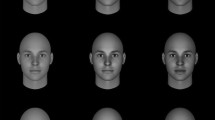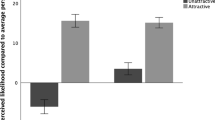Abstract
First impressions are often influenced by the context in which we experience them. Many factors, such as behavior, appearance, and our own personal attitudes can affect the way that these perceptions are constructed. The present experiment sought to examine the effect of positive norm violation on females’ perceptions of male facial attractiveness. Two male faces (attractive and unattractive) with similar features were partnered with two scenarios of positive norm violation (low intensity and high intensity) while being rated on personality characteristics. Two separate halo effects were hypothesized in the experiment: attractiveness and high violation. An interaction effect in the form of a magnified halo was also predicted. Participants were 178 female college students. Results showed favorable ratings for the attractive male face and the low violation condition, with the attractive, low violation condition receiving the most positive results. Data supported a significant effect for positive norm violation, but not for male facial attractiveness. A significant interaction effect between the two variables was also observed.
Similar content being viewed by others
References
Abrams, D., Marques, J., Bown, N., & Henson, M. (2000). Pro-norm and anti-norm deviance within and between groups. Journal of Personality and Social Psychology, 78, 906–912.
Abrams, D., Marques, J., Bown, N., & Dougill, M. (2002). Anti-norm and pro-norm deviance in the bank and on the campus: Two experiments on subjective group dynamics. Group Processes Intergroup Relations, 5, 163.
Ben-Yehuda, N. (1990). Positive and negative deviance: More fuel for a controversy. Deviant Behavior, 11, 221–243.
Brauer, M., & Chekroun, P. (2005). The relationship between perceived violation of social norms and social control: Situational factors influencing the reaction to deviance. Journal of Applied Social Psychology, 35, 1–22.
Burgoon, J., Buller, D., Hale, J., & DeTurck, M. (1984). Relational messages associated with nonverbal behaviors. Human Communication Research, 10, 351–378.
Dion, K. (1972). Physical attractiveness and evaluation of children’s transgressions. Journal of Personality and Social Psychology, 24, 207–213.
Dion, K. (1973). Young children’s stereotyping of facial attractiveness. Developmental Psychology, 9, 183–188.
Franco, Z., Blau, K., & Zimbardo, P. (2011). Heroism: A conceptual analysis and differentiation between heroic action and altruism. Review of General Psychology, 15, 99–113.
Forgas, J. (2011). She just doesn’t look like a philosopher…? Affective influences on the halo effect in impression formation. European Journal of Social Psychology, 41, 812–817.
Gibson, J., & Gore, J. S. (2015). You’re OK until you misbehave: How norm violations magnify the attractiveness devil effect. Gender Issues, 4, 266–278.
Kruger, D. (2006). Male facial masculinity influences attributions of personality and reproductive strategy. Personal Relationships, 13, 451–463.
Larose, H., & Standing, L. (1998). Does the halo effect occur in the elderly? Social Behavior and Personality, 26, 147–150.
Lucker, G., Beane, W., & Helmreich, R. (2001). The strength of the halo effect in physical attractiveness research. Journal of Psycology, 107, 69–75.
Lyman, B., Hatlelid, D., & Macurdy, C. (1981). Stimulus-person cues in first-impression attraction. Perceptual and Motor Skills, 52, 59–66.
Macapagal, K., Rupp, H., & Heiman, J. (2011). Influences of observer sex, facial masculinity, and gender role identification on first impressions of men’s faces. Journal of Social, Evolutionary, and Cultural Psychology, 5, 92–105.
Miller, A. (1970). Role of physical attractiveness in impression formation. Psychonomic Science, 19, 241–243.
Nisbett, R., & Wilson, T. (1977). The halo effect: Evidence for unconscious alteration of judgements. Journal of Personality and Social Psychology, 35, 250–256.
Palmer, J., & Feldman, J. (2005). Accountability and Need for cognition effects on contrast, halo, and accuracy in performance ratings. Journal of Psychology, 136, 119–137.
Quist, M., Watkins, C., Smith, F., Little, A., DeBruine, L., & Jones, B. (2012). Sociosexuality predicts women’s preferences for symmetry in men’s faces. Archives of Sexual Behavior, 41, 1415–1421.
Spreitzer, G., & Sonenshein, S. (2004). Toward the construct definition of positive deviance. American Behavioral Scientist, 47, 828–847.
Talley, L., & Temple, S. (2015). How leaders influence followers through the use of nonverbal communication. Leadership & Organization Development Journal, 36, 69–80.
Thorndike, E. L. (1920). A constant error in psychological ratings. Journal of Applied Psychology, 4(1), 25–29.
Willis, J., & Todorov, A. (2006). First impressions making up your mind after a 100-ms exposure to a face. Psychological Science, 17(7), 592–598.
Wolf, B., & Zuckerman, P. (2011). Deviant heroes: Nonconformists as agents of justice and social change. Deviant Behavior, 33, 639–654.
Zebrowitz, L., & Franklin, R. (2014). The attractiveness halo effect and the babyface stereotype in older and younger adults: Similarities, own-age accentuation, and older adult positivity effects. Experimental Aging Research, 40, 375–393.
Author information
Authors and Affiliations
Corresponding author
Ethics declarations
Conflict of interest
The authors declares that they have no conflict of interest.
Ethical standard
All procedures performed in studies involving human participants were in accordance with the ethical standards of the institutional and/or national research committee and with the 1964 Helsinki declaration and its later amendments or comparable ethical standards.
Informed consent
Informed consent was obtained from all individual participants included in the study.
Rights and permissions
About this article
Cite this article
Gibson, J.L., Gore, J.S. Is He a Hero or a Weirdo? How Norm Violations Influence the Halo Effect. Gend. Issues 33, 299–310 (2016). https://doi.org/10.1007/s12147-016-9173-6
Published:
Issue Date:
DOI: https://doi.org/10.1007/s12147-016-9173-6




